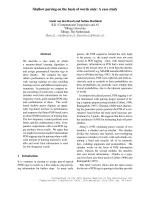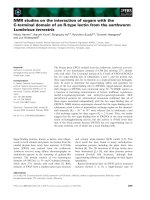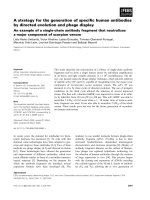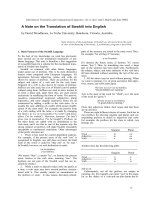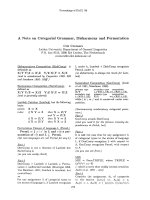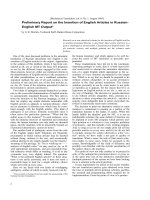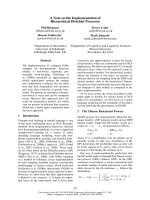Báo cáo khoa học: "A Note on the Translation of Swahili into English" pot
Bạn đang xem bản rút gọn của tài liệu. Xem và tải ngay bản đầy đủ của tài liệu tại đây (133.64 KB, 3 trang )
[Mechanical Translation and Computational Linguistics, vol.11, nos.1 and 2, March and June 1968]
A Note on the Translation of Swahili into English
by David Woodhouse, La Trobe University, Bundoora, Victoria, Australia
Some features of the morphology of Swahili are discussed from the point
of view of mechanizing a dictionary. A preliminary program is described.
1. Basic Features of the Swahili Language
To the best of my knowledge, no work has previously
been carried out on the mechanical translation of any
Bantu language. This note is therefore a first suggestion
of a possible basis for a scheme for the mechanical trans-
lation of Swahili into English.
Swahili, in common with other Bantu languages,
makes great use of prefixes. This is its most distinctive
feature when compared with European languages. All
agreements between adjectives, nouns, and verbs are
shown by means of prefixes. There are prefixes for the
subject and object of a verb and for the verb tense.
Negation of a verb is also shown by means of prefixes.
Suffixes are also used, but a lot of Swahili can be spoken
without using them. Suffixes are used to show motion to
or from a place and, apart from this, are used almost
exclusively in modifying the form of verbs. The passive,
causative, prepositional, reciprocal, subjunctive, plural
imperative, and some singular imperative forms are all
constructed by adding a suffix to the verb stem. As is
usually the case, addition of a suffix often causes modifi-
cation of the stem itself. For example, the passive form
of a verb ending with the letter a is made by changing
the final a to wa, as in kuandika ("to write") and kuan-
dikwa ("to be written"). However, kununua ("to buy")
gives rise to kununuliwa ("to be bought"). Prefixes, on
the other hand, are added with no amendment to the
verb stem, and I see this as one of the reasons why the
strong reliance on prefixes will make Swahili reasonably
susceptible to mechanical translation. Other advantages
of the prefix structure are:
1. There is less need for context-dependent analysis.
For example, if the present tense of the verb "run" is
recognized in English, one still does not know the final
form of the word: it could be "they run" or "he runs."
In Swahili, however, no such distinction is made:
wa-na-kimbea,
a-na-kimbea.
(Wa means "they"; a means "he"; na denotes the present
tense; kimbea is the verb stem, meaning "run." The
hyphens are not part of the Swahili word but are in-
serted for clarity.)
2. While a noun or adjective takes only one prefix at
a time, a verb stem may have several prefixes concate-
nated with it. This usually entails no amendments to
the prefixes or stem. It also means that many related
parts of the sentence are joined in the same word. Thus,
for example, "he will buy it" becomes
a-ta-ki-nunua.
(Ta denotes the future tense; ki denotes "it"; nunua
means "buy.") Thus, by translating one word, a large
part of the sentence has been dealt with. Furthermore,
the subject, object, and tense indicator of the verb have
all been obtained without searching the rest of the sen-
tence.
3. All the above may be used without parsing. When
we come to parsing, it is of great assistance that adjec-
tives, nouns, and verbs must agree.
Wa-toto wa-zuri wa-na-kimbea.
"Good children are running."
Toto is the stem of the word for "child"; zuri, the stem
of the word for "good.")
M-toto m-zuri a-na-kimbea.
"A good child is running."
(Note that adjectives follow their nouns and that there
are no articles.)
There are eight different classes of nouns. Each has its
own prefixes for showing singular and plural, and cor-
responding prefixes to attach to adjectives and verbs.
For example, the prefixes for the class to which -toto
belongs are:
Singular Plural
Noun m wa
Adjective m wa
Verb a wa
Another class has the following table:
Singular Plural
Noun u n
Adjective m n
Verb u zi
and so on.
Unfortunately, not all the prefixes are unique in
meaning. Ku, for example, can mean "you" in the singu-
lar as the object of a verb and can also denote the in-
75
finitive. These ambiguities can be resolved, without too
much difficulty, by considering the combination of pre-
fixes in which the prefix in question occurs.
Suffixes differ from prefixes in two respects: (1) As
already exemplified, suffixes can cause modification of
the word stem. (2) In all but one case, only one suffix
is used at a time. The exceptional case is supplied by two
particular suffixes (e and ni) which can occur together
(as eni). This may be considered as giving rise to an-
other single suffix, namely, the concatenation (eni) of
the two individual suffixes. We may then write the trans-
lation program as if, without exception, only one suffix
is used at any one time.
These differences make it more efficient to deal quite
differently with prefixes and suffixes. We note in passing
that a disadvantage of Swahili is the absence of articles.
Some work must be done on this problem (paralleling
[1]) to determine whether there are word patterns
which are indicative of the need to insert an article, and
of which article to insert.
2. Structure of the Translation Scheme
Three dictionaries are envisaged: a stem dictionary, a
prefix dictionary, and a suffix dictionary. If one were
dealing with suffixes only (rather than with suffixes and
prefixes), the appropriate procedure would clearly be as
follows: If no match is found in the stem dictionary for
a source-language word, the last letter is elided, and a
match sought for the truncated word. This elision and
comparison is continued until the first few letters of the
original word are found as an entry in the stem diction-
ary. Thus, we know that, given any input string (word)
of n letters, either (1) there is some integer m ≤ n such
that the first m letters of the input word appear as an
entry in the stem dictionary, or (2) no such m exists, and
the word is unrecognizable by this dictionary. Since we
wish to permit recognition of prefixes, however, with
these entered in a separate dictionary, we have a third
possibility: (3) there are integers r, s, 0 < r ≤ s ≤ n
such that letters r to s inclusive of the input word appear
as an entry in the stem dictionary. We no longer have a
fixed base (the beginning of the word), and we have
introduced much more freedom, and many more subsets
of each input string to be checked.
Furthermore, we must guard against faulty recog-
nitions. If "anti" were an entry in the prefix dictionary,
we should try to remove this prefix from the beginning
of a word whenever possible—but must not "recognize"
it in the word "antique," for example. My suggestion
for Swahili translation deals with this difficulty, as fol-
lows.
A word is taken from the incoming source text, and
attempts are made to recognize prefixes and suffixes. All
prefixes have one or two letters, and the two-letter ones
are recognized first, in an attempt to prevent spurious
recognitions. If the first two letters are the same as an
entry in the prefix dictionary, a note is made of the
prefix, these two letters are dropped from the word, and
the third and fourth letters are compared. When no
more two-letter prefixes are found, a search is made for
one-letter ones. If one is found, it is noted, the letter is
dropped from the word, and a search is made for two-
letter prefixes again. When no more prefixes can be
found, we have some recognized prefixes, the remainder
of the word being regarded as the stem. The stem dic-
tionary is now searched for this stem. If it is found, the
associated meaning, and the meanings of the recognized
prefixes, are printed out, and the program moves to the
next word of the source text. If it is not found, however,
we should not immediately assume that the word is
unknown to the dictionary (see the above comment on
"antique").
We now replace the prefixes, one by one, in all possi-
ble (order-preserving) combinations. Thus, we replace
the last prefix and try to recognize the resulting stem. If
we are unsuccessful, we replace the next prefix, and so
on. If all the prefixes are replaced with no recognition
taking place, we move to consideration of suffixes.
One suffix may be considered as a complete addition
to the word it modifies, namely, ni. Nyumba means
"house"; nyumbani means "to the house" (or "at the
house," or "from the house," depending on context).
Most other suffixes are applied to verbs.
Most verbs end with the letter a. (Some verbs, of
Arabic origin, end in i, u, or e. We have not dealt with
these, but the necessary extension is not difficult.) In a
Swahili-English dictionary, the verb "to buy" is entered
as nunua (or kununua) and the noun "child" as mtoto. In
our stem dictionary, however, we enter the stem toto and
the "normal form" nunua, rather than the stem nunu.
This is because the singular and plural forms mtoto and
watoto appear with comparable frequency. It is there-
fore more efficient always to search for the stem toto,
and then check the prefix for number. In the case of verb
forms, however, the active voice, in unmodified form,
occurs far more frequently than any of the other forms,
such as passive, imperative, reciprocal, and so on. It is
therefore more efficient to search first for the basic form.
If no recognition takes place, we may then check for
suffixes. This takes place as follows. If a final e is found,
we may suppose the word to be a verb in imperative
or subjunctive mood, replace the e by a, and check the
resulting word to see if it is a verb in unmodified form.
If the word does not end in e, we look for other verb
endings (such as ana [reciprocal], liwa [passive]) and,
whenever one is recognized, replace it by a and check
the resulting word. This manner of dealing with verb
suffixes clearly differs from the manner of dealing with
prefixes.
3. The Program
The scheme as described above has so far been imple-
mented in
FORTRAN on ICL 1900 series computers. To
use a scientific language for this purpose seems ludi-
76
WOODHOUSE
crous, but there is a good practical reason. If a program
to translate Swahili into English is to be useful (rather
than purely academic research), it must be usable in
Tanzania. Until recently, the only computers available
in Tanzania were smaller processors from ICL's 1900
series, on which no list-processing language has been
implemented. In order to develop this project, it had
to be made to fit the local situation.
So far, only the basic idea, described above, has been
implemented as a word-for-word dictionary lookup. No
parsing of the input string or restructuring of the output
string takes place. Only simple sentences (not involving
subordinate clauses) have been translated.
The program accepts input in a form which may easily
be prepared by a typist.
4. Results
Working with 28, 12, and 230 entries in the prefix, suffix,
and stem dictionaries, respectively, the results obtained
have been encouraging, although not faultless. For ex-
ample,
a-li-amkwa
means
"he was awoken."
(A means "he" or "she"; li denotes the past tense; amkwa
is the verb stem meaning "be awoken.") The program
translated this as
He/She Past He/She Sing To/By/With/For.
Clearly, besides the correct recognition of prefixes a and
li, prefixes a and m (denoting a reference to a personal
noun in the singular) have been spuriously recognized
in amkwa, because the preposition kwa is entered in the
stem dictionary. However, all such erroneous translations
encountered so far could be avoided by simple checks
on allowable sequences of prefixes.
Much, however, still remains to be done if the English
reader is not to have to use great mental agility to con-
strue the computer output. The next major step must
be to implement some automatic parsing of the Swahili
input.
Received January 28, 1970
References
1. Martins, G. P. "Preliminary Report on the Insertion of
English Articles in Russian-English MT Output." Mechani-
cal Translation, vol. 8, no. 1 (August 1964).
TRANSLATION OF SWAHILI INTO ENGLISH 77
